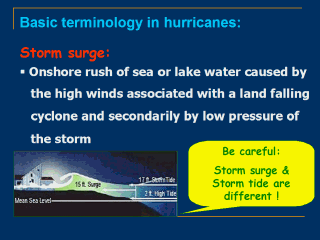 |
Storm surge is simply water that is pushed
toward the shore by the force of the winds swirling around the storm. This
advancing surge combines with the normal tides to create the hurricane storm
tide, which can increase the mean water level 15 feet or more. In addition,
wind driven waves are superimposed on the storm tide. This rise in water
level can cause severe flooding in coastal areas, particularly when the
storm tide coincides with the normal high tides. Because much of the United
States' densely populated Atlantic and Gulf Coast coastlines lie less than
10 feet above mean sea level, the danger from storm tides is tremendous.
The level of surge in a particular area is also determined by the slope of
the continental shelf. A shallow slope off the coast (right, top picture)
will allow a greater surge to inundate coastal communities. Communities with
a steeper continental shelf (right, bottom picture) will not see as much
surge inundation, although large breaking waves can still present major
problems. Storm tides, waves, and currents in confined harbours severely
damage ships, marinas, and pleasure boats. |
